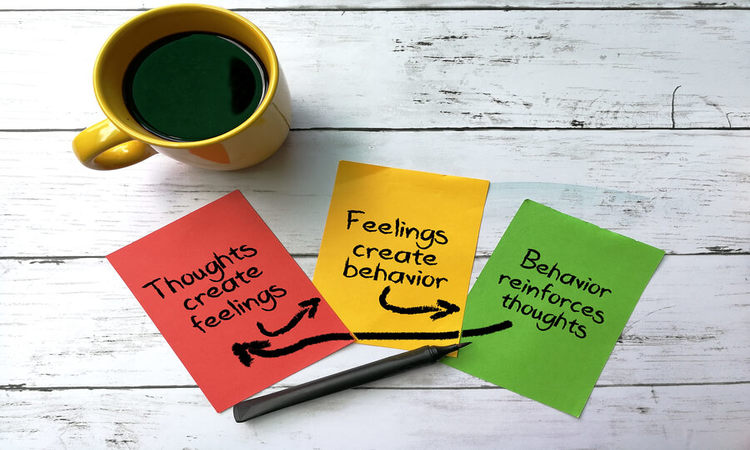
Cognitive behavioral therapy exercises help individuals address negative thoughts and feelings to overcome addiction. Cognitive behavioral therapy (CBT) is widely used today in addiction treatment. CBT teaches people in recovery how to identify connections between thoughts, feelings, and actions and improve awareness of how they influence recovery.
Besides addiction, CBT also treats co-occurring mental health conditions such as the following:
- Anxiety disorders
- Bipolar disorder
- Eating disorders
- Obsessive-compulsive disorder (OCD)
- Post-traumatic stress disorder (PTSD)
- Attention-deficit hyperactivity disorder (ADHD)
How Cognitive Behavioral Therapy Exercises Work
To people who practice it, cognitive behavioral therapy reveals to people who practice it that many adverse behaviors and emotions are not rational or logical. Instead, these feelings and actions may be based on past experiences or environmental factors.
When a person with addiction understands why they feel or behave in a certain way, and how those feelings and actions contribute to substance use, they are more adequately equipped to overcome addiction.
Cognitive behavioral therapists work with recovering addicts to identify their adverse “automatic” thoughts. Automatic thoughts are images or mental activity that occur as a response to a trigger. They ‘pop up’ in a person’s mind without conscious thought and are often derived from misconceptions and internalized self-doubt and fear.
Often, people attempt to self-medicate these unpleasant or painful thoughts and feelings by drinking alcohol or using drugs. By continually revisiting and confronting these painful memories with a therapist, recovering addicts can mitigate the pain produced by them. They can then learn new healthy behaviors to displace their drug or alcohol abuse.
Cognitive Behavioral Therapy Exercises and Addiction Treatment
Automatic negative thoughts are often the main cause of depression and anxiety disorders, which are disorders that commonly co-occur with addiction. This means that the presence of automatic thoughts can make a person more likely to use drugs and alcohol as well.
CBT can help patients defeat drug addiction and alcoholism by doing the following:
- Helping to dismiss the erroneous beliefs and insecurities that contribute to substance abuse
- Providing self-help tools to improve mood
- Teaching effective communication skills
Cognitive behavioral therapy also helps recovering addicts cope with triggers in three fundamental ways, according to the National Institute on Drug Abuse:
Recognize – Identify circumstances that lead to drinking or drug use.
Avoid – Remove oneself from trigger situations whenever possible and appropriate.
Cope – Use CBT exercises to address and mitigate unhealthy emotions and thoughts that contribute to substance abuse.
Cognitive Behavioral Therapy Exercises
Cognitive behavioral therapists employ specific exercises to help facilitate addiction recovery. Examples of CBT exercises used in addiction treatment include the following:
Recording Thoughts

Recovering addicts assess automatic adverse thoughts and look for objective evidence that supports and disproves those thoughts. They record and cross-compare evidence for and against their automatic thoughts and assumptions. The goal is to help the person think more balanced, rational, and less self-critical thoughts by evaluating what they’re thinking and feeling.
Example:
“My boss thinks I’m incompetent and I need to drink to feel better” is replaced with “It’s normal to make mistakes, and I can learn from this. I don’t need to drink alcohol to feel better about myself.”
Behavioral Exercises
These exercises contradict unhealthy thoughts against healthy ones to see which is more effective in altering behavior. Many individuals respond better to self-kindness than to self-criticism. Behavioral exercises are about determining what approach works best for the person.
Example:
“If I’m hard on myself after excessive drinking, I’ll drink less” versus “If I am merciful to myself after excessively drinking, I’ll drink less.”
Imagery-Based Exposure
In this exercise, recovering addicts and alcoholics recall a memory that induces powerful adverse feelings. They pay attention to every sight, sound, emotion, and thought during that moment. By repeatedly revisiting unpleasant memories, over time the addicted person can decrease the anxiety caused by them.
Example:
A man focuses on a painful memory from childhood. He remembers every detail and emotion at the moment. Upon repeated exposure, the memory induces less and less pain, and thereby reduces the need to self-medicate with substances.
Pleasant Activity Schedule
This exercise involves creating a weekly list of healthy and fun activities to split up daily routines. These tasks should be easy to perform while fostering positive emotions. Scheduling these enjoyable activities helps to reduce negative automatic thoughts and the corresponding need to use drugs or drink alcohol.
Example:
In place of using drugs or drinking on the job, a stressed out divorce attorney relaxes at her desk for fifteen minutes every day and uses the time to listen to her favorite music.
Finding the Resources Needed to Overcome Addiction
Overcoming addiction requires the help of many people and resources. Drug addiction treatment can help you achieve sobriety and avoid relapse. Recovery By The Sea employs mental health counselors and addiction specialist who teach the life skills necessary to maintain long-term recovery.
In addition to cognitive behavior therapy, we offer individual and group counseling, peer group support, psychoeducation, and aftercare planning. Please contact us today to find out how we can help you or a loved one recover from addiction and reclaim the fulfilling life you deserve!
Related: Holistic Therapy in Addiction Treatment